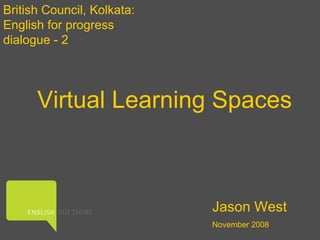Virtual learning spaces_elt_content_bc_india-secondpolicy-presentation-jasonwest
- 1. Virtual Learning Spaces British Council, Kolkata: English for progress dialogue - 2 Jason West November 2008
- 2. Who am I? Jason West 'CV' 42 years old Co-founded and marketed ŌĆśdifferentŌĆÖ English school in 1992 - British Council accredited within 2.5 years Consultant to British Council 1999 Created English Out There 2001 Likes: Beer Dislikes: Bigotry
- 3. Introduction Question Definitions Me and my experiences The VLS ŌĆśland grabŌĆÖ Thinking ŌĆśoutside the boxŌĆÖ (literally) Summary
- 4. Seminar ŌĆś Future Direction in Language Teaching and LearningŌĆÖ http://www.alistair-smith.co.uk/readings/leading_learning/leading_learning6.htm Role of technology Best approach 20 delegates Keri Facer, Head of Learning Research, NESTA Futurelab
- 5. QuestionŌĆ” Summarise your best experiences as a language learner and think about the ideal form of technology that might support you as you learn? Write it down, fold it over, and give it to the person on your left. Now forget about it .
- 6. Virtual Internet and communication technology fostered de-coupling of space where events happen , and storage technologies facilitate de-coupling of time between a message being sent and received. These technologies build the environment for virtual work in teams, with members who may never meet each other in person . Communicating by telephone and e-mail, with work products shared electronically , virtual teams produce results without being co-located . - wikipedia
- 7. Learning Noun S: (n) learning , acquisition (the cognitive process of acquiring skill or knowledge) "the child's acquisition of language" S: (n) eruditeness , erudition , learnedness , learning , scholarship , encyclopedism , encyclopaedism (profound scholarly knowledge) ŌĆō Princeton Wordnet
- 8. Space A space is just like a folder, but more: it can hold any type of content. wiki.alfresco.com/wiki/Terminology_Guide
- 9. In short Virtual Learning SpacesŌĆ” Can contain or use any content Events happen there Remote teams who may never meet share things electronically there Skill or knowledge is acquired
- 10. VoIP Voice over Internet Protocol (VoIP) enables broadband users to send voice calls via the Internet. There are now a number of these services in operation and calls can be made free of charge. www.broadband-expert.co.uk/broadband/broadband-glossary.php
- 11. Why me? English Out There Different dynamic Active use of alternative learning space i.e. real world Re-thought conventional methodology Psycholinguistics and constructivism ŌĆō i.e. brain friendly VoIP Skype ŌĆō www.skype.com
- 12. My search for my own VoIP Contacted Skype Contacted large telecoms outsourcing companies Googled for 10 months (Feb ŌĆÖ06 to Jan ŌĆÖ07) Wrote four proposals Signed 4 confidentiality agreements
- 13. Bingo! Whitephone ŌĆ£ A white label voice enabled browser with feature rich communications functionalities -- including voice mail, video mail, free PC to PC calls, and low cost calls to telephones globallyŌĆØ
- 14. It looks like │┘│¾Š▒▓§ŌĆ”
- 15. Issues Client side application Video (One to One or Group) Electronic whiteboard File sharing Session recording
- 16. GordonŌĆÖs big announcement Jan ŌĆś08 Teaching English to the world using VoIP Scalability? Type of teachers? Technology? Training? Budget? Other? (remember this)
- 17. More things to think about Bandwidth available Dial-up 56kbps Mobile datacard ŌĆō 350 kbps (wireless broadband) ADSL ŌĆō 500 kbps (broadband) Broadband ŌĆō 2 Mbps to 24 Mbps Client or Cloud side Firewalls Ease of use Cost User numbers Proprietary or white label Language
- 18. What could he be talking about? VoIP Skype Google Talk Instant Messenger Engage (Whitephone) Virtual Learning Environments (VLEs) Moodle Blackboard Web conferencing programmes WebEx Gotomeeting
- 19. So many to choose from What about a combination of all of them?
- 20. What does one look like?
- 21. Wiziq.com Free for individual users Embeds in your website (in approx. 3 weeks time) White label for $50 per annum India
- 22. What about this one?
- 23. ╠²
- 24. Remaining issues Turn-taking Visual communication cues Non-visual communication cues Processing power/bandwidth Other (remember?)
- 25. ╠²
- 26. Space and experience management ŌĆś ClosedŌĆÖ or finite spaces (why?) Classroom + Virtual Learning Space ŌĆś OpenŌĆÖ or infinite spaces (why not?) Real world + Cyber Space Direction of technology to recreate life-like spaces and experiences Experiences Interpersonal, emotional, meaningful memorable (hopefully in the case of planned learning) Focus on managing learner experiences not spaces
- 27. = Content Investment Technology Publishers Established educational systems Conventional thought Other =
- 28. Free online classroom www.skype.com docs.google.com http://www.whiteboardmeeting.com/ Second Life Or just go to http://www.futureu.com/technology/index.html
- 29. That questionŌĆ”
- 30. They ALL answeredŌĆ”a ŌĆ£virtual advisor, providing authentic interaction, as well as feedback, support and advice for learners. It would be a softly spoken, reliable and very attractive friend, providing support and advice whenever needed, and encouraging self-confidence and independence.ŌĆØ E.gŌĆ”
- 31. An in-country personal robotŌĆ” A Second Life avatarŌĆ” Technology
- 32. ŌĆ” a good English Out There teacher orŌĆ” Real world A native speaking and very patient friend with lots of time to killŌĆ”
- 33. Virtual classroom sessions that are: Carefully structured Based around real practice with fluent and native speakers ŌĆś HappeningsŌĆÖ, ŌĆśeventsŌĆÖ or ŌĆś tasksŌĆÖ linked to the taught language Designed to be brain friendly i.e. memorable and therefore lead to ŌĆśacquisitionŌĆÖ i.e. learning
- 35. We have the technology and it will only improve. We need to examine how we use unlimited space to learn. We need to create managed real processes involving comprehensible input and real, meaningful verbal interaction. We need to combine 2. and 3. inside teaching and learning materials. Summary
- 36. ╠²





































